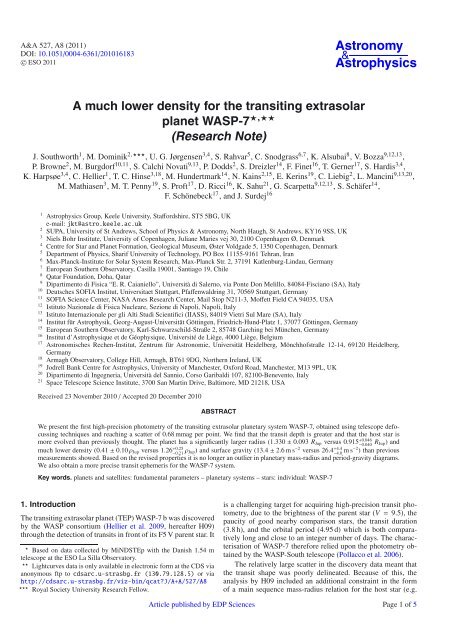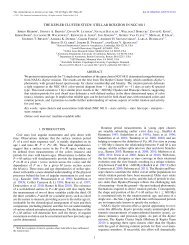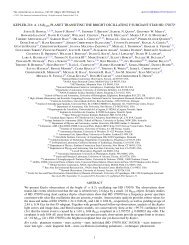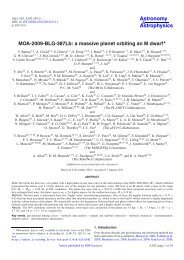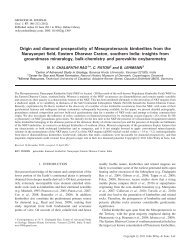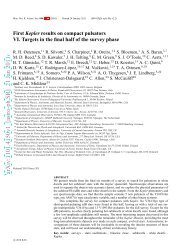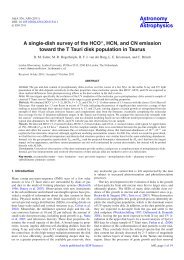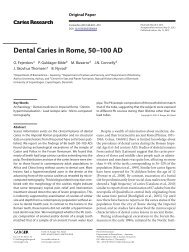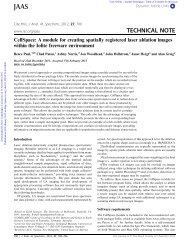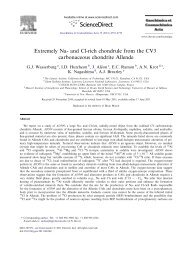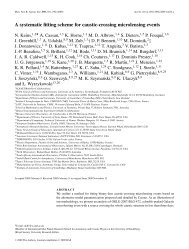PDF (250.5 KB) - Astronomy & Astrophysics
PDF (250.5 KB) - Astronomy & Astrophysics
PDF (250.5 KB) - Astronomy & Astrophysics
Create successful ePaper yourself
Turn your PDF publications into a flip-book with our unique Google optimized e-Paper software.
A&A 527, A8 (2011)<br />
DOI: 10.1051/0004-6361/201016183<br />
c○ ESO 2011<br />
A much lower density for the transiting extrasolar<br />
planet WASP-7 ⋆,⋆⋆<br />
(Research Note)<br />
<strong>Astronomy</strong><br />
&<br />
<strong>Astrophysics</strong><br />
J. Southworth 1 , M. Dominik 2,⋆⋆⋆ , U. G. Jørgensen 3,4 ,S.Rahvar 5 , C. Snodgrass 6,7 ,K.Alsubai 8 , V. Bozza 9,12,13 ,<br />
P. Browne 2 , M. Burgdorf 10,11 , S. Calchi Novati 9,13 , P. Dodds 2 , S. Dreizler 14 ,F.Finet 16 ,T.Gerner 17 ,S.Hardis 3,4 ,<br />
K. Harpsøe 3,4 , C. Hellier 1 ,T.C.Hinse 3,18 , M. Hundertmark 14 ,N.Kains 2,15 ,E.Kerins 19 ,C.Liebig 2 ,L.Mancini 9,13,20 ,<br />
M. Mathiasen 3 ,M.T.Penny 19 ,S.Proft 17 ,D.Ricci 16 ,K.Sahu 21 ,G.Scarpetta 9,12,13 , S. Schäfer 14 ,<br />
F. Schönebeck 17 , and J. Surdej 16<br />
1 <strong>Astrophysics</strong> Group, Keele University, Staffordshire, ST5 5BG, UK<br />
e-mail: jkt@astro.keele.ac.uk<br />
2 SUPA, University of St Andrews, School of Physics & <strong>Astronomy</strong>, North Haugh, St Andrews, KY16 9SS, UK<br />
3 Niels Bohr Institute, University of Copenhagen, Juliane Maries vej 30, 2100 Copenhagen Ø, Denmark<br />
4 Centre for Star and Planet Formation, Geological Museum, Øster Voldgade 5, 1350 Copenhagen, Denmark<br />
5 Department of Physics, Sharif University of Technology, PO Box 11155-9161 Tehran, Iran<br />
6 Max-Planck-Institute for Solar System Research, Max-Planck Str. 2, 37191 Katlenburg-Lindau, Germany<br />
7 European Southern Observatory, Casilla 19001, Santiago 19, Chile<br />
8 Qatar Foundation, Doha, Qatar<br />
9 Dipartimento di Fisica “E. R. Caianiello”, Università di Salerno, via Ponte Don Melillo, 84084-Fisciano (SA), Italy<br />
10 Deutsches SOFIA Institut, Universitaet Stuttgart, Pfaffenwaldring 31, 70569 Stuttgart, Germany<br />
11 SOFIA Science Center, NASA Ames Research Center, Mail Stop N211-3, Moffett Field CA 94035, USA<br />
12 Istituto Nazionale di Fisica Nucleare, Sezione di Napoli, Napoli, Italy<br />
13 Istituto Internazionale per gli Alti Studi Scientifici (IIASS), 84019 Vietri Sul Mare (SA), Italy<br />
14 Institut für Astrophysik, Georg-August-Universität Göttingen, Friedrich-Hund-Platz 1, 37077 Göttingen, Germany<br />
15 European Southern Observatory, Karl-Schwarzschild-Straße 2, 85748 Garching bei München, Germany<br />
16 Institut d’Astrophysique et de Géophysique, Université de Liège, 4000 Liège, Belgium<br />
17 Astronomisches Rechen-Institut, Zentrum für Astronomie, Universität Heidelberg, Mönchhofstraße 12-14, 69120 Heidelberg,<br />
Germany<br />
18 Armagh Observatory, College Hill, Armagh, BT61 9DG, Northern Ireland, UK<br />
19 Jodrell Bank Centre for <strong>Astrophysics</strong>, University of Manchester, Oxford Road, Manchester, M13 9PL, UK<br />
20 Dipartimento di Ingegneria, Università del Sannio, Corso Garibaldi 107, 82100-Benevento, Italy<br />
21 Space Telescope Science Institute, 3700 San Martin Drive, Baltimore, MD 21218, USA<br />
Received 23 November 2010 / Accepted 20 December 2010<br />
ABSTRACT<br />
We present the first high-precision photometry of the transiting extrasolar planetary system WASP-7, obtained using telescope defocussing<br />
techniques and reaching a scatter of 0.68 mmag per point. We find that the transit depth is greater and that the host star is<br />
more evolved than previously thought. The planet has a significantly larger radius (1.330 ± 0.093 RJup versus 0.915 +0.046<br />
−0.040 RJup) and<br />
much lower density (0.41 ± 0.10 ρJup versus 1.26 +0.25<br />
−0.21 ρJup) and surface gravity (13.4 ± 2.6ms−2 versus 26.4 +4.4<br />
−4.0 ms−2 ) than previous<br />
measurements showed. Based on the revised properties it is no longer an outlier in planetary mass-radius and period-gravity diagrams.<br />
We also obtain a more precise transit ephemeris for the WASP-7 system.<br />
Key words. planets and satellites: fundamental parameters – planetary systems – stars: individual: WASP-7<br />
1. Introduction<br />
The transiting extrasolar planet (TEP) WASP-7 b was discovered<br />
by the WASP consortium (Hellier et al. 2009, hereafter H09)<br />
through the detection of transits in front of its F5 V parent star. It<br />
⋆ Based on data collected by MiNDSTEp with the Danish 1.54 m<br />
telescope at the ESO La Silla Observatory.<br />
⋆⋆ Lightcurves data is only available in electronic form at the CDS via<br />
anonymous ftp to cdsarc.u-strasbg.fr (130.79.128.5) or via<br />
http://cdsarc.u-strasbg.fr/viz-bin/qcat?J/A+A/527/A8<br />
⋆⋆⋆ Royal Society University Research Fellow.<br />
is a challenging target for acquiring high-precision transit photometry,<br />
due to the brightness of the parent star (V = 9.5), the<br />
paucity of good nearby comparison stars, the transit duration<br />
(3.8 h), and the orbital period (4.95 d) which is both comparatively<br />
long and close to an integer number of days. The characterisation<br />
of WASP-7 therefore relied upon the photometry obtained<br />
by the WASP-South telescope (Pollacco et al. 2006).<br />
The relatively large scatter in the discovery data meant that<br />
the transit shape was poorly delineated. Because of this, the<br />
analysis by H09 included an additional constraint in the form<br />
of a main sequence mass-radius relation for the host star (e.g.<br />
Article published by EDP Sciences Page 1 of 5
Anderson et al. 2010). The radius, surface gravity and density of<br />
the planet resulting from their analysis are Rb = 0.91 +0.046<br />
−0.040 RJup,<br />
gb = 26.4 +4.4<br />
−4.0 ms−2 and ρb = 1.26 +0.25<br />
−0.21 ρJup, respectively. These<br />
values placed WASP-7 b in an outlier position in the mass–radius<br />
diagram of TEPs, having one of the largest densities within the<br />
main planet population (masses < ∼2 MJup). This was interpreted<br />
by H09 as evidence that WASP-7 b has a massive heavy-element<br />
core.<br />
In this work we present the first follow-up photometric observations<br />
obtained for WASP-7. The high precision of our observations<br />
(0.68 mmag scatter) allows us to obtain the physical<br />
properties of the transiting system without needing to impose<br />
any constraints on the parameters of the parent star. We find a<br />
substantially larger radius, and therefore a lower density and surface<br />
gravity. We also greatly improve the orbital ephemeris for<br />
the system, so transit midpoints in the 2011 observing season<br />
can be predicted to within 45 s instead of 27 min.<br />
2. Observations and data reduction<br />
WASP-7 was observed from 00:14 to 07:18 UT on the date<br />
2010/09/07. We used the 1.54 m Danish telescope at ESO<br />
La Silla, equipped with the DFOSC focal-reducing CCD imager.<br />
A total of 217 integrations were obtained through a Gunn I filter<br />
(ESO filter #425) and with an exposure time of 60 s. The<br />
CCD was windowed down in order to reduce readout time, resulting<br />
in a dead time of 50 s between individual observations.<br />
The telescope was defocussed to a point spread function diameter<br />
of 38 pixels (15 ′′ ) in order to average out flat-fielding noise<br />
and avoid saturating the CCD.<br />
The data were reduced using a pipeline which implements<br />
the daophot aperture photometry routine (Stetson 1987). The images<br />
were debiassed and flat-fielded, and slight pointing variations<br />
were detected and accounted for by cross-correlating<br />
against a reference image. A differential-magnitude light curve<br />
was constructed by simultaneously fitting a straight line to the<br />
out-of-transit observations plus weights to the reference stars<br />
used to create the ensemble comparison star. We find that the<br />
sizes of the software apertures and the choice of comparison<br />
stars has very little effect on the shape of the observed transit. For<br />
our final photometry we adopt the light curve which displays the<br />
lowest scatter with respect to a fitted transit model (see below).<br />
The root-mean-square (rms) of the scatter in this light curve is<br />
0.68 mmag per point. For further details on the approach used to<br />
obtain and reduce the data see Southworth et al. (2009, 2010).<br />
3. Light curve analysis<br />
The light curve of WASP-7 was modelled using the jktebop<br />
code1 , which in turn is based on the ebop program (Popper &<br />
Etzel 1981; Nelson & Davis 1972). The main parameters of the<br />
fit were the sum of the fractional radii of the star and planet,<br />
rA + rb = RA+Rb<br />
a<br />
rb<br />
where a is the semimajor axis, their ratio, k =<br />
and the orbital inclination, i. After a preliminary fit was obtained,<br />
the measurement errors were rescaled to give a reduced χ 2 of 1.0.<br />
In order to provide an accurate measure of the orbital period we<br />
included the time of mid-transit quoted by H09, using the approach<br />
given by Southworth et al. (2007a). This results in an<br />
orbital ephemeris of:<br />
T0 = BJD(TDB) 2 455 446.63493(30) + 4.9546416(35) × E<br />
1 jktebop is written in fortran77 and the source code is available at<br />
http://www.astro.keele.ac.uk/~jkt/codes/jktebop.html<br />
Page 2 of 5<br />
A&A 527, A8 (2011)<br />
rA<br />
Fig. 1. Phased light curve of WASP-7 compared to the best fit found<br />
using jktebop. The residuals of the fits are plotted at the base of the<br />
figure, offset from zero.<br />
where E is the number of orbital cycles after the reference epoch<br />
and the bracketed quantities denote the uncertainty in the final<br />
digit of the preceding number. This ephemeris is on the<br />
BJD(TDB) timescale (Eastman et al. 2010). The timestamps in<br />
our data were manually verified to be correct to within ±2s.<br />
Limb darkening (LD) was included and its uncertainty accounted<br />
for using five different functional laws, and solutions<br />
were obtained for the cases when both coefficients were fixed to<br />
theoretical values, the linear coefficient was fitted for, and both<br />
coefficients were fitted for. Theoretical values were calculated<br />
for the measured effective temperature and surface gravity of the<br />
star by linearly interpolating within the tables of Van Hamme<br />
(1993)andClaret (2000). The results for each of these modelling<br />
runs are given in Table 1. We find that the results for different<br />
LD laws are generally in good agreement, although the amount<br />
of LD is lower than theoretically predicted.<br />
Uncertainties in the fitted parameters were obtained using<br />
Monte Carlo and residual-permutation simulations (Southworth<br />
2008; Jenkins et al. 2002). We are able to reject the solutions<br />
with all LD coefficients fixed to theoretical values, as they provide<br />
a clearly worse fit to the data. The solutions where two LD<br />
coefficients are fitted are marginally the best ones, so for the final<br />
parameters we adopt their mean values from these four solutions.<br />
We adopt the parameter uncertainties from the residual<br />
permutation algorithm, which are roughly 1.5 times larger than<br />
the Monte Carlo alternatives. This implies that correlated noise<br />
is significant in our data, as expected from visual inspection of<br />
the plot of the best fit (Fig. 1). The final parameter values and<br />
uncertainties are given in Table 2. Compared to those from H09,<br />
we find a solution with a lower orbital inclination and larger fractional<br />
radius for both the star and the planet. Our results were<br />
obtained using the methods of Southworth (2008) and are homogeneous<br />
with the results in that work.<br />
4. The physical properties of WASP-7<br />
The light curve parameters alone do not allow the physical properties<br />
of the WASP-7 system to be calculated. Additional observed<br />
properties are available from H09: the star’s orbital velocity<br />
amplitude (KA = 97 ± 13 m s −1 ), effective temperature<br />
(Teff = 6400 ± 100 K), surface gravity (log g = 4.3 ± 0.2) and
J. Southworth et al.: A much lower density for the transiting exoplanet WASP-7 (RN)<br />
Table 1. Parameters of the jktebop best fits of the light curve of WASP-7, using different approaches to limb darkening (LD).<br />
Linear LD law Quadratic LD law Square-root LD law Logarithmic LD law Cubic LD law<br />
All LD coefficients fixed:<br />
rA + rb 0.1255 ± 0.0052 0.1180 ± 0.0049 0.1194 ± 0.0048 0.1184 ± 0.0051 0.1223 ± 0.0046<br />
k 0.09598 ± 0.00089 0.09480 ± 0.00075 0.09524 ± 0.00075 0.09475 ± 0.00082 0.09633 ± 0.00060<br />
i ( ◦ ) 86.61 ± 0.52 87.43 ± 0.59 87.23 ± 0.56 87.39 ± 0.63 86.80 ± 0.47<br />
uA 0.43 fixed 0.20 fixed 0.00 fixed 0.55 fixed 0.20 fixed<br />
vA 0.30 fixed 0.60 fixed 0.25 fixed 0.15 fixed<br />
rA 0.1145 ± 0.0047 0.1078 ± 0.0044 0.1090 ± 0.0044 0.1081 ± 0.0046 0.1116 ± 0.0041<br />
rb 0.01099 ± 0.00053 0.01022 ± 0.00048 0.01038 ± 0.00048 0.01025 ± 0.00051 0.01075 ± 0.00045<br />
σ (mmag) 0.7136 0.6977 0.6946 0.7015 0.6828<br />
Fitting for the linear LD coefficient and perturbing the nonlinear LD coefficient:<br />
rA + rb 0.1224 ± 0.0043 0.1192 ± 0.0047 0.1227 ± 0.0046 0.1221 ± 0.0047 0.1200 ± 0.0044<br />
k 0.09675 ± 0.00069 0.09587 ± 0.00072 0.09646 ± 0.00065 0.09628 ± 0.00069 0.09623 ± 0.00071<br />
i ( ◦ ) 86.77 ± 0.44 87.15 ± 0.55 86.77 ± 0.48 86.83 ± 0.49 87.05 ± 0.49<br />
uA 0.245 ± 0.047 0.059 ± 0.064 –0.134 ± 0.059 0.387 ± 0.064 0.190 ± 0.051<br />
vA 0.30 perturbed 0.60 perturbed 0.25 perturbed 0.15 perturbed<br />
rA 0.1116 ± 0.0039 0.1088 ± 0.0043 0.1119 ± 0.0042 0.1113 ± 0.0043 0.1095 ± 0.0039<br />
rb 0.01080 ± 0.00043 0.01043 ± 0.00047 0.01079 ± 0.00045 0.01072 ± 0.00046 0.01054 ± 0.00042<br />
σ (mmag) 0.6841 0.6829 0.6826 0.6825 0.6827<br />
Fitting for both LD coefficients:<br />
rA + rb 0.1216 ± 0.0050 0.1199 ± 0.0049 0.1221 ± 0.0054 0.1196 ± 0.0050<br />
k 0.09583 ± 0.00115 0.09537 ± 0.00145 0.09575 ± 0.00148 0.09527 ± 0.00151<br />
i ( ◦ ) 86.91 ± 0.56 87.15 ± 0.60 86.89 ± 0.63 87.18 ± 0.63<br />
uA –0.021 ± 0.256 –0.866 ± 0.979 0.578 ± 0.391 0.066 ± 0.131<br />
vA 0.42 ± 0.41 1.83 ± 1.60 0.56 ± 0.60 0.54 ± 0.45<br />
rA 0.1110 ± 0.0045 0.1095 ± 0.0045 0.1114 ± 0.0049 0.1092 ± 0.0045<br />
rb 0.01064 ± 0.00051 0.01044 ± 0.00051 0.01067 ± 0.00055 0.01040 ± 0.00052<br />
σ (mmag) 0.6826 0.6818 0.6820 0.6817<br />
metallicity ( <br />
Fe<br />
H = 0.0 ± 0.1). Of these, the surface gravity is<br />
quite imprecise so is only useful as a consistency check.<br />
In order to calculate the physical properties of WASP-7 we<br />
use the same approach as in Southworth (2009). Firstly, we adopt<br />
tabulated predictions from theoretical models of low-mass stars.<br />
Secondly, we guess an initial value of the velocity amplitude of<br />
the planet, Kb. We then use the known rA, rb, i, KA and orbital<br />
period to calculate the physical properties of the system. The observed<br />
Teff and calculated RA are then compared to the modelpredicted<br />
values for a star of the calculated mass (MA), and Kb<br />
is adjusted until the best match is found. This is performed for<br />
a grid of ages covering 0.1 to 20 Gyr in 0.1 Gyr steps, by which<br />
the overall best physical properties and age are found. The uncertainty<br />
in each of the input parameters is propagated by repeating<br />
this procedure with the parameter perturbed, resulting in a detailed<br />
error budget for every output parameter.<br />
The above procedure is performed five times, using independent<br />
sets of theoretical model predictions. These are: Claret<br />
(Claret 2004), Y2 (Demarque et al. 2004), Teramo (Pietrinferni<br />
et al. 2004), VRSS (VandenBerg et al. 2006) andDSEP (Dotter<br />
et al. 2008). The final value for each of the physical properties<br />
is taken to be the unweighted mean of the values found using<br />
the five different model sets. The random error is taken to be the<br />
largest of the individal errors found by the perturbation analysis.<br />
The systematic error is the standard deviation of the values<br />
from the five different model sets. The results for each model set<br />
are given in Table 3. The final physical properties of WASP-7<br />
are collected in Table 4 and compared to those found by H09.<br />
In this table the quantity T ′<br />
eq is the equilibrium temperature of<br />
the planet excluding the energy redistribution factor (Southworth<br />
2009) andΘis the Safronov (1972) number. We find that the<br />
star is slightly evolved, allowing a reasonable estimate of its age<br />
(2.4 ± 1.0 Gyr).<br />
Table 2. Final parameters of the fits to the light curve of WASP-7,<br />
compared to the results from H09.<br />
This work H09<br />
rA + rb 0.1207 ± 0.0068 0.1001<br />
k 0.0956 ± 0.0016 0.0761 ± 0.0008<br />
i ( ◦ ) 87.03 ± 0.93 89.6 +0.4<br />
−0.9<br />
rA 0.1102 ± 0.0061 0.0930<br />
rb 0.01053 ± 0.00070 0.00708<br />
5. Summary and conclusions<br />
We have observed a transit of the WASP-7 system using defocussed<br />
photometry techniques, resulting in a light curve with an<br />
rms scatter of only 0.68 mmag. These data were modelled with<br />
the jktebop code, and the results used to determine the physical<br />
properties of the planet and its host star. The higher quality of<br />
our photometry has allowed us to measure the system properties<br />
without constraining the host star to follow a main-sequence<br />
mass-radius relation. Compared to H09, we find both a larger radius<br />
for the host star and a larger ratio of the radii of the planet<br />
and star. This results in a sizeable increase in the planetary ra-<br />
dius, from 0.915 +0.046<br />
−0.040 RJup to 1.330 ± 0.093 RJup, which in turn<br />
means a lower surface gravity and mean density.<br />
We have collected literature measurements of the physical<br />
properties of the 96 known TEPs as of 2010/11/18. For 30 of<br />
these objects we used the results of the homogeneous analysis<br />
performed by Southworth (2010). In Fig. 2 we plot their masses<br />
and radii, plus the values from WASP-7 found in this work (filled<br />
circle) and from H09 (open circle). The H09 results for WASP-<br />
7 b indicated that it was one of the densest known TEPs below<br />
∼2 MJup, along with the more recently-discovered planets<br />
Page 3 of 5
A&A 527, A8 (2011)<br />
Table 3. Derived physical properties of WASP-7 using five different sets of theoretical stellar models.<br />
(Claret models) (Y 2 models) (Teramo models) (VRSS models) (DSEP models)<br />
Kb (kms −1 ) 135.6 ± 2.1 135.6 ± 1.9 135.1 ± 2.2 135.4 ± 1.9 134.4 ± 2.2<br />
MA (M⊙) 1.285 ± 0.059 1.287 ± 0.054 1.273 ± 0.061 1.280 ± 0.052 1.254 ± 0.061<br />
RA (R⊙) 1.436 ± 0.092 1.436 ± 0.092 1.431 ± 0.092 1.434 ± 0.090 1.424 ± 0.092<br />
log gA (cgs) 4.233 ± 0.047 4.233 ± 0.047 4.231 ± 0.047 4.232 ± 0.047 4.229 ± 0.047<br />
Mb (MJup) 0.96± 0.13 0.96 ± 0.13 0.96 ± 0.13 0.96 ± 0.13 0.95 ± 0.13<br />
Rb (RJup) 1.333 ± 0.093 1.334 ± 0.093 1.329 ± 0.093 1.331 ± 0.092 1.322 ± 0.092<br />
ρb ( ρJup) 0.407 ± 0.101 0.406 ± 0.101 0.408 ± 0.101 0.407 ± 0.101 0.410 ± 0.102<br />
Θ 0.069 ± 0.011 0.069 ± 0.010 0.070 ± 0.011 0.070 ± 0.011 0.070 ± 0.011<br />
a (AU) 0.06185 ± 0.00095 0.06188 ± 0.00086 0.06166 ± 0.00098 0.06177 ± 0.00084 0.06134 ± 0.00100<br />
Age (Gyr) 2.5 +0.5<br />
−1.0<br />
2.5 +0.2<br />
−1.0<br />
Table 4. Final physical properties of WASP-7 compared to those found<br />
by H09.<br />
This work (final) H09<br />
MA (M⊙) 1.276 ± 0.061 ± 0.022 1.28 +0.09<br />
−0.19<br />
RA (R⊙) 1.432 ± 0.092 ± 0.008 1.236 +0.059<br />
−0.046<br />
log gA (cgs) 4.232 ± 0.047 ± 0.003 4.363 +0.010<br />
−0.047<br />
ρA (ρ⊙) 0.434 ± 0.074<br />
Mb (MJup) 0.96± 0.13 ± 0.01 0.96 +0.12<br />
−0.18<br />
Rb (RJup) 1.330 ± 0.093 ± 0.008 0.915 +0.046<br />
−0.040<br />
gb (m s −1 ) 13.4 ± 2.6 26.4 +4.4<br />
−4.0<br />
ρb (ρJup) 0.41 ± 0.10 1.26 +0.25<br />
−0.21<br />
T ′<br />
eq (K) 1487 ± 48 1379 +35<br />
−23<br />
Θ 0.070 ± 0.011 ± 0.000<br />
a (AU) 0.0617 ± 0.0010 ± 0.0004 0.0618 +0.0014<br />
−0.0033<br />
Age (Gyr) 2.4 +0.8 +0.3<br />
−1.0 −0.4<br />
Notes. The second errorbars represent systematic errors.<br />
CoRoT-13 b (Cabrera et al. 2010) and HAT-P-15 b (Kovács et al.<br />
2010). The outlier status has now been lifted: our results place<br />
WASP-7 b in a well-populated part of the mass-radius diagram<br />
and demonstrate that high-quality data is required to obtain reliable<br />
measurements of the properties of TEPs.<br />
Figure 3 shows the surface gravities of the known TEPs as a<br />
function of their orbital periods. The existing planet population<br />
shows an inverse correlation between period and surface gravity<br />
(Southworth et al. 2007b), at least for the dominant population<br />
with periods < ∼10 d and masses < ∼3 MJup (see also Fressin et al.<br />
2009). The revised properties of WASP-7 b move it from outlier<br />
status to within the sprawl of parameter space occupied by the<br />
general planet population.<br />
The theoretical models of irradiated gas giant planets<br />
Bodenheimer et al. (2003), Fortney et al. (2007) andBaraffe<br />
et al. (2008) predict radii of no more than 1.16 RJup for a 1.0 MJup<br />
planet with a range of chemical compositions and core masses,<br />
and without an arbitrary additional heating source. Our upward<br />
revision of the radius of WASP-7 b means that it no longer<br />
matches the predictions of these models at the 2σ level. These<br />
conclusions could be strengthened by the provision of more<br />
radial velocity measurements as well as the acquisition of further<br />
photometric observations.<br />
Acknowledgements. J.S. acknowledges funding from STFC in the form of an<br />
Advanced Fellowship. We thank the referee for comments which helped to improve<br />
the paper. Astronomical research at Armagh Observatory is funded by the<br />
Department of Culture, Arts & Leisure (DCAL). J. Surdej, D.R. (boursier FRIA)<br />
and F.F. acknowledge support from the Communauté française de Belgique –<br />
Actions de recherche concertées – Académie Wallonie-Europe.<br />
Page 4 of 5<br />
2.3 +0.6<br />
−0.8<br />
2.0 +0.7<br />
−0.6<br />
2.7 +0.8<br />
−0.7<br />
Fig. 2. Plot of the masses and radii of the known TEPs. The blue<br />
symbols denote values from the homogeneous analysis of Southworth<br />
(2010) and the red symbols results for the other known TEPs. WASP-<br />
7 is shown in black with an open circle (H09) and a filled circle (this<br />
work). Grey dotted lines show where density is 1.0, 0.5 and 0.25 ρJup.<br />
Fig. 3. Plot of the orbital periods and surface gravities of the known<br />
TEPs. The symbols are the same as for Fig. 2.
References<br />
J. Southworth et al.: A much lower density for the transiting exoplanet WASP-7 (RN)<br />
Anderson, D. R., Hellier, C., Gillon, M., et al. 2010, ApJ, 709, 159<br />
Baraffe, I., Chabrier, G., & Barman, T. 2008, A&A, 482, 315<br />
Bodenheimer, P., Laughlin, G., & Lin, D. N. C. 2003, ApJ, 592, 555<br />
Cabrera, J., Bruntt, H., Ollivier, M., et al. 2010, A&A, 522, A110<br />
Claret, A. 2000, A&A, 363, 1081<br />
Claret, A. 2004, A&A, 424, 919<br />
Demarque, P., Woo, J.-H., Kim, Y.-C., & Yi, S. K. 2004, ApJS, 155, 667<br />
Dotter, A., Chaboyer, B., Jevremović, D., et al. 2008, ApJS, 178, 89<br />
Eastman, J., Siverd, R., & Gaudi, B. S. 2010, PASP, 122, 935<br />
Fortney, J. J., Marley, M. S., & Barnes, J. W. 2007, ApJ, 659, 1661<br />
Fressin, F., Guillot, T., & Nesta, L. 2009, A&A, 504, 605<br />
Hellier, C., Anderson, D. R., Gillon, M., et al. 2009, ApJ, 690, L89<br />
Jenkins, J. M., Caldwell, D. A., & Borucki, W. J. 2002, ApJ, 564, 495<br />
Kovács, G., Bakos, G. Á., Hartman, J. D., et al. 2010, ApJ, 724, 866<br />
Nelson, B., & Davis, W. D. 1972, ApJ, 174, 617<br />
Pietrinferni, A., Cassisi, S., Salaris, M., & Castelli, F. 2004, ApJ, 612, 168<br />
Pollacco, D. L., Skillen, I., Cameron, A. C., et al. 2006, PASP, 118, 1407<br />
Popper, D. M., & Etzel, P. B. 1981, AJ, 86, 102<br />
Safronov, V. S. 1972, Evolution of the Protoplanetary Cloud and Formation of<br />
the Earth and Planets (Jerusalem: Israel Program for Scientific Translation)<br />
Southworth, J. 2008, MNRAS, 386, 1644<br />
Southworth, J. 2009, MNRAS, 394, 272<br />
Southworth, J. 2010, MNRAS, 408, 1689<br />
Southworth, J., Bruntt, H., & Buzasi, D. L. 2007a, A&A, 467, 1215<br />
Southworth, J., Wheatley, P. J., & Sams, G. 2007b, MNRAS, 379, L11<br />
Southworth, J., Hinse, T. C., Jørgensen, U. G., et al. 2009, MNRAS, 396, 1023<br />
Southworth, J., Mancini, L., Calchi Novati, S., et al. 2010, MNRAS, 408, 1680<br />
Stetson, P. B. 1987, PASP, 99, 191<br />
Van Hamme, W. 1993, AJ, 106, 2096<br />
VandenBerg, D. A., Bergbusch, P. A., & Dowler, P. D. 2006, ApJS, 162, 375<br />
Page 5 of 5


